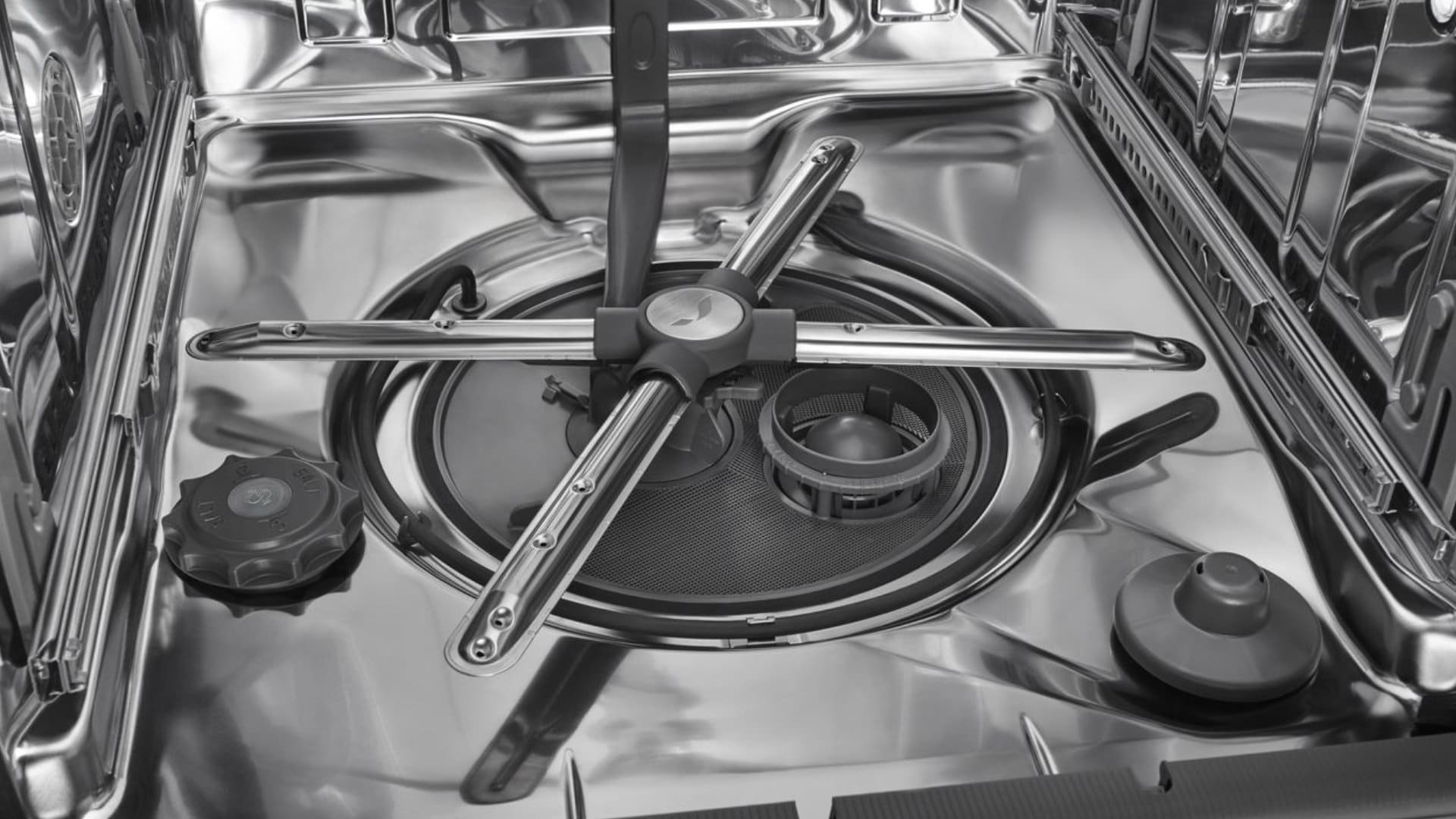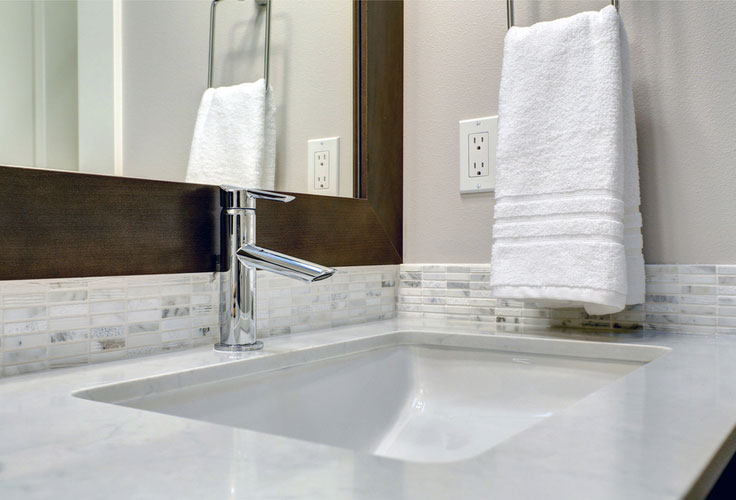A Kitchenaid dishwasher not draining may be caused by a clogged or faulty drain pump.
Common Causes Of A Kitchenaid Dishwasher Not Draining
One of the most frustrating problems to encounter with your Kitchenaid dishwasher is when it fails to drain properly. A dishwasher that doesn’t drain can lead to standing water at the bottom of the appliance, which not only hampers its functionality but also creates an unhygienic environment in your kitchen. To help you troubleshoot this issue effectively, let’s take a closer look at the common causes behind a Kitchenaid dishwasher not draining.
Clogged Drain Hose
A clogged drain hose is a common culprit behind a Kitchenaid dishwasher not draining. The drain hose is responsible for carrying the dirty water out of the dishwasher and into the sink or disposal. Over time, food particles, grease, and debris can accumulate in the hose, obstructing the flow of water. Additionally, the drain hose may also become kinked or detached, further impeding proper drainage.
To check for a clogged drain hose, follow these steps:
- Turn off the dishwasher and unplug it from the power source for safety.
- Locate the drain hose, which is usually connected to the sink or garbage disposal.
- Check for any visible blockages, such as food particles or solidified grease.
- If there are no visible obstructions, detach the drain hose from both ends and flush it with water to remove any hidden debris.
- Reconnect the drain hose securely and test the dishwasher to see if the draining issue has been resolved.
Blocked Filter
The dishwasher filter plays a crucial role in preventing food particles and debris from clogging the drain pump and drain hose. However, if the filter becomes dirty or clogged, it can inhibit proper drainage. A blocked filter is a relatively easy fix that can often resolve the issue of a Kitchenaid dishwasher not draining.
Follow these steps to check and clean the dishwasher filter:
- Turn off the dishwasher and unplug it from the power source.
- Locate the filter assembly, which is typically situated on the bottom of the dishwasher.
- Remove the filter by twisting or lifting, depending on the model.
- Inspect the filter for any debris or clogs.
- Clean the filter under running water or use a soft brush to remove stubborn dirt.
- Once the filter is clean, reattach it securely and restart the dishwasher to verify if the draining problem is resolved.
Faulty Drain Pump
A faulty drain pump can also contribute to a Kitchenaid dishwasher not draining properly. The drain pump is responsible for pumping the water out of the dishwasher and into the drain hose. If the pump is damaged or malfunctioning, it won’t be able to efficiently remove the water, resulting in poor drainage.
To determine if the drain pump is faulty, try the following:
- Turn off and unplug the dishwasher for safety.
- Locate the drain pump, which is typically situated at the bottom of the dishwasher.
- Inspect the pump for any visible signs of damage or blockage.
- If there are no obvious issues, use a multimeter to test the pump for proper functionality. Consult the manufacturer’s manual for specific instructions on how to perform this test.
- If the drain pump is indeed faulty, it may need to be replaced. Contact a professional technician or refer to the manufacturer’s guidelines for assistance.
By investigating these common causes of a Kitchenaid dishwasher not draining, you can identify and resolve the issue promptly, ensuring uninterrupted functionality of your dishwasher and a clean kitchen environment.
Clearing A Clogged Drain Hose
One common issue with Kitchenaid dishwashers is a clogged drain hose. When the drain hose is obstructed, it prevents water from properly draining out of the dishwasher, leading to all sorts of problems from standing water to foul odors. To rectify this issue, follow these simple steps to locate, remove, inspect, flush, clean, and reinstall the drain hose.
Locate And Remove The Drain Hose
The first step in clearing a clogged drain hose is to locate and remove it from the dishwasher. It’s important to do this before attempting any cleaning or flushing procedures. Follow these steps:
- Turn off the power supply to the dishwasher by unplugging it or flipping the circuit breaker.
- Open the dishwasher door and remove the bottom dish rack to gain access to the drain hose.
- Using a screwdriver or pliers, loosen the hose clamp connecting the drain hose to the dishwasher drain pump.
- Gently pull the drain hose off the drain pump and out of the dishwasher.
- Set the drain hose aside for inspection and cleaning.
Inspect The Drain Hose For Clogs
Once you have removed the drain hose, carefully inspect it for any clogs or blockages that might be causing the drainage issue. Here are some things to look for:
- Obvious debris such as food particles, paper, or plastic
- Kinks or bends in the hose that impede the flow of water
- Cracks, splits, or damage to the hose that could be causing leaks
If you notice any of the above issues, it is essential to clear them before proceeding to the next step.
Flush And Clean The Drain Hose
Now that you have inspected the drain hose and identified any clogs or damage, it’s time to flush and clean it thoroughly. Follow these steps:
- Take the clogged drain hose to a sink or tub where you can easily access it.
- Using a high-pressure stream of water, flush the hose in the opposite direction of water flow. This will help dislodge any debris or clogs within the hose.
- If necessary, use a long, flexible brush or pipe cleaner to manually remove any stubborn debris from the hose.
- Continue flushing and cleaning the hose until the water runs clear and freely through it.
Reinstall The Drain Hose
After thoroughly flushing and cleaning the drain hose, it’s time to reconnect it to the dishwasher. Follow these steps:
- Insert one end of the drain hose back into the dishwasher drain pump.
- Secure the hose with the clamp, making sure it is tight enough to prevent leaks but not so tight that it damages the hose.
- Feed the other end of the drain hose into the sink or drain pipe, ensuring it is properly aligned and free of any kinks or bends.
- Double-check that all connections are secure and tight.
Once you have completed these steps, you can test your Kitchenaid dishwasher to see if the draining issue has been resolved. If the problem persists or you encounter any difficulties during this process, it may be best to consult a professional or contact Kitchenaid customer support for further assistance.
Unblocking The Filter
A common issue that many Kitchenaid dishwasher owners encounter is a dishwasher not draining properly. One of the reasons for this problem could be a clogged or blocked filter. The filter plays a crucial role in preventing food particles and debris from clogging the drain and interfering with the dishwasher’s draining mechanism. In this section, we will guide you through the steps to unblock the filter and restore your dishwasher’s draining efficiency.
Access The Dishwasher Filter
To begin, you need to locate and access the dishwasher filter. The filter is usually located at the bottom of the dishwasher, beneath the lower spray arm. It serves as a trap for larger food particles and debris. Accessing the filter may vary depending on the model of your Kitchenaid dishwasher, so consult your appliance’s manual for specific instructions.
Remove And Clean The Filter
Once you have located the filter, gently remove it from its housing. The filter can usually be twisted or unlocked to release it. Take caution not to damage the filter during this process. Once removed, inspect the filter for any obvious signs of blockage or debris. Using a brush or running water, carefully clean the filter to remove any trapped particles. Ensure that the filter is thoroughly cleaned before proceeding to the next step.
Check For Any Debris In The Filter Housing
While the filter is out, take a moment to inspect the filter housing for any debris or blockage. Using a flashlight, look for any food particles, paper labels, or other obstructions that may be clogging the drain. If you spot any debris, remove it using a soft brush or cloth. Be gentle to avoid damaging the filter housing or other dishwasher components.
Reinstall The Filter Correctly
After cleaning the filter and checking the filter housing, it’s time to reinstall the filter correctly. Ensure that the filter is properly aligned with the housing and securely locked or twisted into its place. An improperly installed filter may lead to ineffective filtering and drainage problems. Take a moment to double-check the filter’s position before moving on.
By unblocking the filter, you have taken an essential step towards resolving your Kitchenaid dishwasher’s drainage issues. Performing this maintenance task periodically will help maintain optimal dishwasher performance and avoid future problems. If your dishwasher continues to experience draining problems after unblocking the filter, you may need to consider other possible causes or seek professional assistance.

Credit: flamingoappliance.com
Fixing A Faulty Drain Pump
Is your Kitchenaid dishwasher not draining properly? It could be due to a faulty drain pump. Follow these simple steps to fix the issue and have your dishwasher running smoothly again in no time.
Fixing a Faulty Drain Pump Diagnose a Faulty Drain Pump One of the most common issues that you may encounter with your Kitchenaid dishwasher is a drainage problem. If you notice that water is not draining properly, it could be due to a faulty drain pump. The drain pump is responsible for removing dirty water from the dishwasher after each cycle.
To diagnose this problem, follow the steps below:
1. Start by checking if there is any visible debris or clogs in the drain pump. This can include food particles, small utensils, or other objects that may have accidentally been washed down the drain. Clearing any obstructions can often solve the drainage issue. Access the Drain Pump Once you have diagnosed a faulty drain pump, the next step is to access it for further inspection and cleaning.
Follow these steps to access the drain pump:
1. Disconnect the power supply to your dishwasher to avoid any electrical mishaps.
2. Remove the bottom panel of the dishwasher by unscrewing the screws holding it in place. Keep in mind that the number and location of screws may vary depending on your particular model.
3. Locate the drain pump, which is typically situated at the bottom of the dishwasher near the back. It can usually be recognized by its cylindrical shape and connecting hoses. Inspect and Clean the Drain Pump After gaining access to the drain pump, it’s essential to inspect it for any signs of damage or blockages.
Here’s how: 1. Carefully examine the drain pump for any visible cracks, breaks, or signs of wear and tear. If any damage is detected, it may be necessary to replace the pump entirely.
2. Clean the drain pump by removing any debris or clogs that have accumulated. This can be done by gently removing any objects or using a small brush to dislodge any stubborn particles. Replace the Drain Pump if Necessary If inspecting and cleaning the drain pump does not resolve the issue, you may need to consider replacing it.
Here’s how: 1. Purchase a new drain pump compatible with your Kitchenaid dishwasher model. You can usually find these at appliance stores or online retailers.
2. Follow the manufacturer’s instructions for installation. This typically involves disconnecting and removing the old drain pump, then attaching and securing the new one in its place.
3. Once the replacement is complete, reattach the bottom panel of the dishwasher and restore the power supply. A faulty drain pump can cause significant drainage problems in your Kitchenaid dishwasher. By diagnosing the issue, accessing the drain pump, inspecting and cleaning it, and replacing it when necessary, you can ensure that your dishwasher is working efficiently once again.
Troubleshooting Other Possible Issues
When your Kitchenaid dishwasher is not draining properly, there could be several other possible issues at play. Troubleshooting these issues can help you determine the cause and find a solution. In this section, we will explore some common problems that may be preventing your dishwasher from draining and provide some troubleshooting steps to resolve them.
Check The Garbage Disposal Connection
If your Kitchenaid dishwasher is connected to a garbage disposal, a clog or blockage in the garbage disposal can prevent proper drainage. To troubleshoot this issue:
- Turn off the power to the dishwasher and garbage disposal.
- Inspect the area where the dishwasher drain hose connects to the garbage disposal.
- Ensure the drain hose is properly connected and not kinked or blocked.
- Carefully remove any debris or clogs that may be obstructing the connection.
Ensure Proper Installation Of The Dishwasher
Improper installation of the dishwasher can also cause drainage problems. To ensure proper installation:
- Check if the dishwasher is level by using a carpenter’s level.
- If the dishwasher is not level, adjust the leveling feet accordingly.
- Verify that the dishwasher drain hose is properly positioned and not bent or kinked.
- Inspect the air gap, if applicable, and clean out any debris.
- Ensure the dishwasher door is closing tightly and securely.
Investigate For Plumbing Issues
In some cases, plumbing issues outside of the dishwasher may be causing drainage problems. Here are a few steps to investigate for plumbing issues:
- Check if other sink drains in your kitchen are draining slowly or if there’s a foul odor coming from them.
- If you notice any issues with the kitchen sink drains, try using a plunger to clear any blockages.
- Inspect the dishwasher drain hose for any blockages or kinks.
- If necessary, disconnect the drain hose and clear any debris.
Contact Professional Repair Services If Needed
If you have tried troubleshooting the above issues and your Kitchenaid dishwasher still does not drain properly, it may be time to seek professional help. Contacting a professional repair service can help you diagnose and fix any underlying problems with your dishwasher.
Frequently Asked Questions On Kitchenaid Dishwasher Not Draining
Why Is My Kitchenaid Dishwasher Not Draining Properly?
There could be several reasons why your Kitchenaid dishwasher is not draining properly, including a clogged drain hose, a faulty drain pump, or a blocked air gap.
How Can I Fix A Clogged Drain Hose In My Kitchenaid Dishwasher?
To fix a clogged drain hose in your Kitchenaid dishwasher, you can try removing any debris or obstructions manually or using a drain cleaner specifically designed for dishwashers.
What Should I Do If The Drain Pump In My Kitchenaid Dishwasher Is Faulty?
If the drain pump in your Kitchenaid dishwasher is faulty, you may need to replace it with a new one. Consult the user manual or contact a professional technician for assistance.
What Is An Air Gap In A Kitchenaid Dishwasher And Why Does It Matter For Draining?
An air gap is a device installed on the countertop or sink that prevents wastewater from flowing back into the dishwasher. It is essential for proper draining and preventing contamination.
How Often Should I Clean The Filter In My Kitchenaid Dishwasher?
It is recommended to clean the filter in your Kitchenaid dishwasher at least once a month or as indicated in the user manual. This helps prevent drainage issues and maintain optimal performance.
Can Using The Wrong Detergent Affect The Drainage In My Kitchenaid Dishwasher?
Yes, using the wrong detergent can cause excessive suds and hinder proper drainage in your Kitchenaid dishwasher. Always use a dishwasher detergent specifically designed for use in automatic dishwashers.
Is It Normal For Water To Remain In The Bottom Of My Kitchenaid Dishwasher After A Cycle?
A small amount of water at the bottom of the dishwasher after a cycle is normal. However, if there is a significant amount of water, it may indicate a drainage problem that needs to be addressed.
When Should I Consider Calling A Professional For Help With My Kitchenaid Dishwasher Drainage Issues?
If you have tried troubleshooting steps and your Kitchenaid dishwasher still has drainage issues, it is advisable to call a professional technician for a thorough inspection and repair.
Conclusion
If your Kitchenaid dishwasher is not draining properly, there are several troubleshooting steps you can take. From checking the drain hose for clogs to inspecting the pump and filter, addressing this issue promptly can ensure your dishwasher works efficiently. Remember to consult your user manual or seek professional assistance if needed.
By following these tips, you can restore the functionality of your Kitchenaid dishwasher and keep your kitchen running smoothly.




Leave a Reply